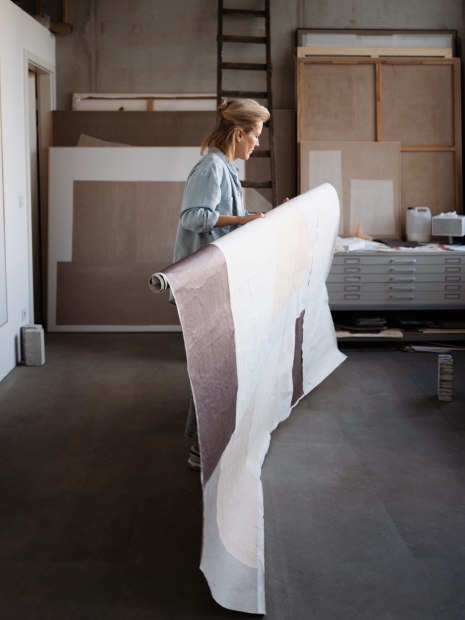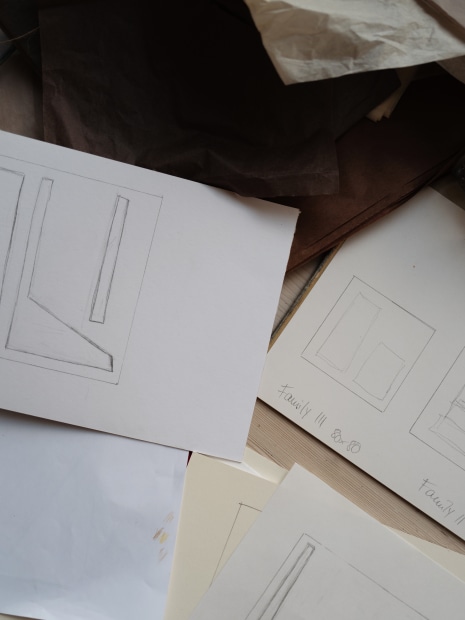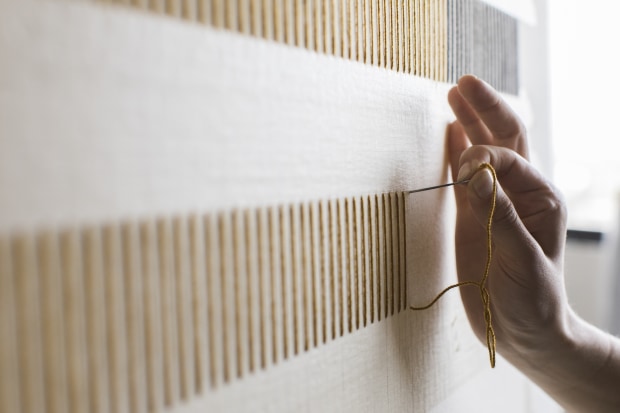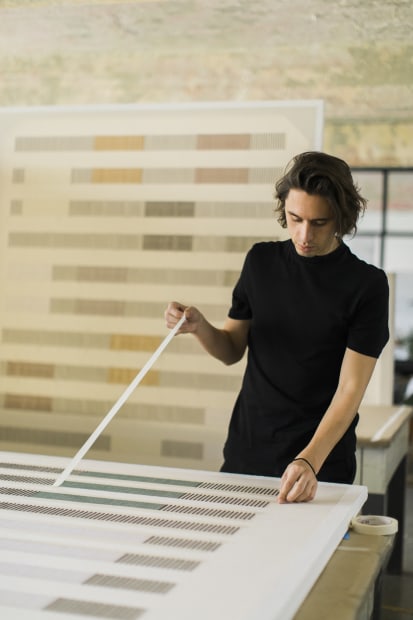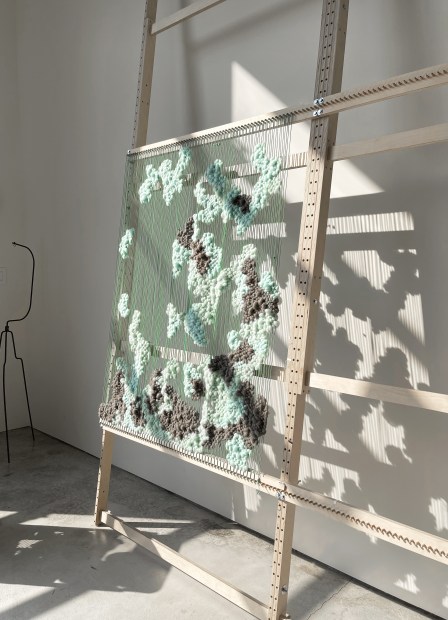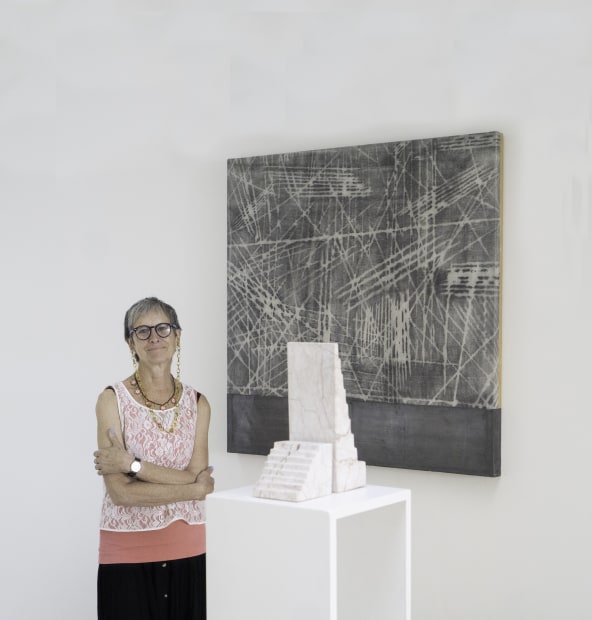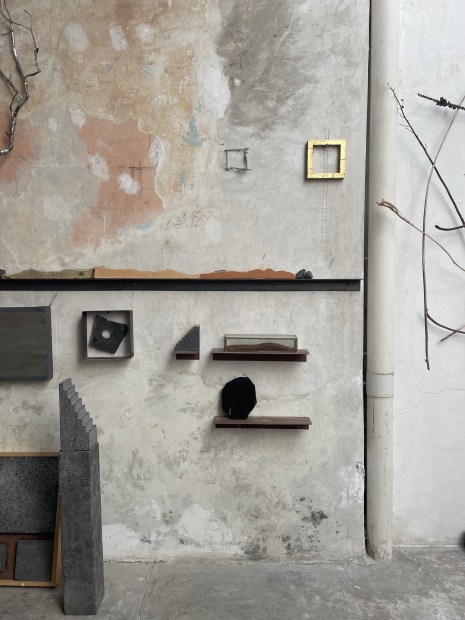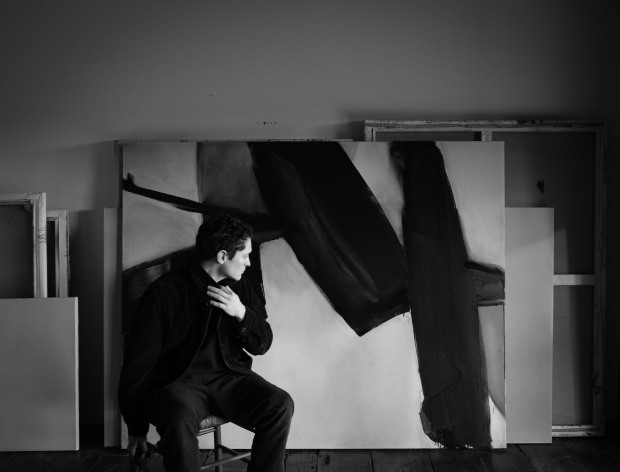-
-
-



Elise Ansel
Using energetic gestural abstraction, Elise Ansel translates Old Master paintings into a contemporary pictorial language. She mines art historical imagery for colour and form, setting aside the narrative and pictorial elements of these paintings and thus creating room for new interpretations. Her works interrupt linear readings of Old Master paintings, repurposing and highlighting the unexpected. The representational content is transformed into a celebration of colour, gesture and the materiality of paint. In the process of reducing her inspirations to their most fundamental forms she retains their power and energy, replacing imagery with dynamic movement and dramatic colour and light. -
Elise AnselEsther,oil on canvas152cm x 102cm (60" x 40")%3Cdiv%20class%3D%26%2334%3Bartist%26%2334%3B%3E%3Cstrong%3EElise%20Ansel%3C/strong%3E%3C/div%3E%3Cdiv%20class%3D%26%2334%3Btitle%26%2334%3B%3E%3Cem%3EEsther%3C/em%3E%2C%3C/div%3E%3Cdiv%20class%3D%26%2334%3Bmedium%26%2334%3B%3Eoil%20on%20canvas%3C/div%3E%3Cdiv%20class%3D%26%2334%3Bdimensions%26%2334%3B%3E152cm%20x%20102cm%20%2860%26%2334%3B%20x%2040%26%2334%3B%29%3C/div%3E
-



Kim Bartelt
Kim Bartelt trained in painting at the Parson’s School of Design but abandoned the medium in favour of using found paper in her compositions. Bartelt painstakingly pastes irregular segments of coloured and transparent sheets of paper to canvas. Her paintings are infused with a delicate energy, embodying the meditative quality of her minute collage process. The sensitivity of the semi-transparent tissue paper used emphasises this process of layering and accumulation. Collected over the years, these re-used fragments allude to their past applications in their wrinkles and folds. In her more recent works, the paper is imbued with a greater sense of conceptuality, reflecting on the nature and physical properties of painting but also as an index linking each painting to its core meanings.
-
Kim BarteltMobile Home VI,paper on linen100cm x 80cm (39" x 31")%3Cdiv%20class%3D%26%2334%3Bartist%26%2334%3B%3E%3Cstrong%3EKim%20Bartelt%3C/strong%3E%3C/div%3E%3Cdiv%20class%3D%26%2334%3Btitle%26%2334%3B%3E%3Cem%3EMobile%20Home%20VI%2C%3C/em%3E%3C/div%3E%3Cdiv%20class%3D%26%2334%3Bmedium%26%2334%3B%3Epaper%20on%20linen%3C/div%3E%3Cdiv%20class%3D%26%2334%3Bdimensions%26%2334%3B%3E100cm%20x%2080cm%20%2839%26%2334%3B%20x%2031%26%2334%3B%29%3C/div%3E
-



Lawrence Calver
Primarily known for his textile works, Lawrence’s work incorporates a variety of fabrics, from cotton silk and linen to suede and wool. Working within the idiom of modernist painting, he takes the material support – the canvas or the plane – and sews, bleaches, stretches or stains the fabric to create works that aims to unify abstraction and representation. Lawrence is at his best working within a limited range of colour; preferring instead to exploit surface, texture and tonality. The grain of the textiles, and the variations in textures have their own beauty through which he conveys an atmosphere and delineation of form. Lawrence sees opportunities in the material before he creates the work. Each piece has an independent identity and in a parental role, Lawrence simply assists in that realisation. Lawrence regards his work as an organic process of experimentation and discovery, led by his materials on a journey of improvisation. He still regards his role in the work as a director, letting serendipity guide the final piece or perhaps, visual performance of his evanescent cast. By working with materials that already have a history – lost in the weave and textures of his creations – Lawrence invites the viewer on a forensic journey. He asks that the audience entertains an idea of a life before the work, a story from manufacture to reclamation that leads to each individual outcome.
-
Lawrence CalverSand,Stitched Linens225cm x 190cm (89" x 75")%3Cdiv%20class%3D%26%2334%3Bartist%26%2334%3B%3E%3Cstrong%3ELawrence%20Calver%3C/strong%3E%3C/div%3E%3Cdiv%20class%3D%26%2334%3Btitle%26%2334%3B%3E%3Cem%3ESand%3C/em%3E%2C%3C/div%3E%3Cdiv%20class%3D%26%2334%3Bmedium%26%2334%3B%3EStitched%20Linens%3C/div%3E%3Cdiv%20class%3D%26%2334%3Bdimensions%26%2334%3B%3E225cm%20x%20190cm%20%2889%26%2334%3B%20x%2075%26%2334%3B%29%3C/div%3E
-



Andreas Diaz Andersson
Andreas Diaz Andersson is a Swedish-Mexican artist known for his distinctly meticulous minimalist abstractions. Andersson’s work is defined by a harmonious use of shapes and lines achieved through the use of textiles and different paint mediums such as acrylic, plasticolour and aerosol paint on cotton canvas. When viewed from afar, Andersson’s carefully considered compositions may look simple, but the complexity of his works becomes clearer upon close inspection. Made with exceptional precision and a meticulous attention to detail, the works are an exploration of depth and form, hovering between illusion and abstraction. By playing with different colours and textures arranged systematically his works attain a spatially reflective quality. The physical, spatial and conceptual depth of the canvas fluctuates based on where the viewer stands, creating a constant variation of dynamic geometric patterns and deep vanishing points.
-
Andreas Diaz AnderssonArrangement 1,Cotton thread and acrylic on canvas130cm x 100cm (51" x 39")%3Cdiv%20class%3D%26%2334%3Bartist%26%2334%3B%3E%3Cstrong%3EAndreas%20Diaz%20Andersson%3C/strong%3E%3C/div%3E%3Cdiv%20class%3D%26%2334%3Btitle%26%2334%3B%3E%3Cem%3EArrangement%201%3C/em%3E%2C%3C/div%3E%3Cdiv%20class%3D%26%2334%3Bmedium%26%2334%3B%3ECotton%20thread%20and%20acrylic%20on%20canvas%3C/div%3E%3Cdiv%20class%3D%26%2334%3Bdimensions%26%2334%3B%3E130cm%20x%20100cm%20%2851%26%2334%3B%20x%2039%26%2334%3B%29%3C/div%3E
-



Edoardo Dionea Cicconi
Edoardo Dionea Cicconi is an Italian contemporary artist working with installations, sculptures, sound and other media. Addressing universal themes often in an interactive way, he tries to find a synthesis between art & science, investigating the concept and perception of “time”. His artworks freeze a subjective dimension in time and become the vehicle of a profound, universal message. His ‘kinetic mirrors’ explore these concepts. While appearing to be simple metal mirrors, these installations interact with their environment; sometimes reflecting space and at other times warping it. Like a black hole, the mirrors create a sense of density, distorting the figure of the viewer until they are no longer visible, merging them with the surrounding space and with the installations themselves. In this way the viewer and their surroundings become an active participant in the artwork, central to its conceptualisation. -
Edoardo Dionea CicconiXYZT Au79 W WS A"kinetic mirror", mirror, white coated metal, electronics57cm x 40.5cm x 8cm (22.5" x 16" x 3")%3Cdiv%20class%3D%26%2334%3Bartist%26%2334%3B%3E%3Cstrong%3EEdoardo%20Dionea%20Cicconi%3C/strong%3E%3C/div%3E%3Cdiv%20class%3D%26%2334%3Btitle%26%2334%3B%3E%3Cem%3EXYZT%20Au79%20W%20WS%20A%3C/em%3E%3C/div%3E%3Cdiv%20class%3D%26%2334%3Bmedium%26%2334%3B%3E%26%2334%3Bkinetic%20mirror%26%2334%3B%2C%20mirror%2C%20white%20coated%20metal%2C%20electronics%3C/div%3E%3Cdiv%20class%3D%26%2334%3Bdimensions%26%2334%3B%3E57cm%20x%2040.5cm%20x%208cm%20%2822.5%26%2334%3B%20x%2016%26%2334%3B%20x%203%26%2334%3B%29%3C/div%3E
-



Mimi Jung
Mimi Jung redefines the traditional practice of weaving, experimenting with intricate new techniques while exploring her own resonant personal experiences. Jung breaks from the conventions of weaving to create her own visual language. Through the spectrum of works originating from the loom, Jung investigates the way people continuously negotiate space within and between themselves. Her work examines multiple dimensions of identity and self-preservation, particularly relating to private and public self-representation and the ways these depictions are manifested through social and cultural mores. Her works play with the expansion or narrowing of space, placing great emphasis on the space existing between the warp and the weft. Her limning of space is reflexive, visible to those who are predisposed to see it.
-
Mimi Jung
Hear Me,
Painted cord, wool, silk and painted panel
120cm x 94cm x 6cm (47" x 37" x 2.5")
%3Cp%20class%3D%26%2334%3Bp1%26%2334%3B%3E%3Cspan%20class%3D%26%2334%3Bs1%26%2334%3B%3E%3Cb%3EMimi%20Jung%3C/b%3E%3C/span%3E%3C/p%3E%3Cp%20class%3D%26%2334%3Bp1%26%2334%3B%3E%3Cspan%20class%3D%26%2334%3Bs1%26%2334%3B%3E%3Ci%3EHear%20Me%3C/i%3E%2C%3C/span%3E%3C/p%3E%3Cp%20class%3D%26%2334%3Bp1%26%2334%3B%3E%3Cspan%20class%3D%26%2334%3Bs1%26%2334%3B%3EPainted%20cord%2C%20wool%2C%20silk%20and%20painted%20panel%3C/span%3E%3C/p%3E%3Cp%20class%3D%26%2334%3Bp1%26%2334%3B%3E%3Cspan%20class%3D%26%2334%3Bs1%26%2334%3B%3E120cm%20x%2094cm%20x%206cm%20%2847%26%2334%3B%20x%2037%26%2334%3B%20x%202.5%26%2334%3B%29%3C/span%3E%3C/p%3E -



Tycjan Knut
Tycjan Knut creates subtle abstractions. Using delicate tonal differences and neutral colours, his works have an effect that verges on optical illusion. His compositions require time and thought. What meets the eye at a glance may not be all it seems after a closer inspection. Knut’s paintings unfold slowly, with multiple anchor points drawing the viewer’s eye across the painting and creating a sense of balance. By building up overlapping layers of colour in a way that resembles the organic world, he creates images that trick the eye into perceiving new depth in already highly structural objects. Without using sketches or plans, Knut’s practice is reactive. The artist carefully follows the formation of the composition, examining the function of each element in relation to the painting as a whole throughout. Knut’s work takes inspiration from the geometric abstract art of the twentieth century with a deep academic interest in unknown abstract ‘masters’. His work resonates with the echo of this tradition but extends beyond the trend, his works freed from the constraints of formula. -
Tycjan KnutUntitled 78,acrylic on canvas180cm x 160cm (71" x 63")%3Cdiv%20class%3D%26%2334%3Bartist%26%2334%3B%3E%3Cstrong%3ETycjan%20Knut%3C/strong%3E%3C/div%3E%3Cdiv%20class%3D%26%2334%3Btitle%26%2334%3B%3E%3Cem%3EUntitled%2078%3C/em%3E%2C%3C/div%3E%3Cdiv%20class%3D%26%2334%3Bmedium%26%2334%3B%3Eacrylic%20on%20canvas%3C/div%3E%3Cdiv%20class%3D%26%2334%3Bdimensions%26%2334%3B%3E180cm%20x%20160cm%20%2871%26%2334%3B%20x%2063%26%2334%3B%29%3C/div%3E
-



Perla Krauze
Perla Krauze works with a number of materials from lead, clay and water to stone. Using graphite frottages from stones and pavements and engraved volcanic rocks from El Pedregal, her paintings are abstract topographies and mappings. Stone is a fundamental material in her practice; linked to memory and durability, it can also be transformed and eroded. The crosshatch patterns in her paintings derive from the lines made in stone cutting, emphasising the transformation of stone from raw material to art object. Described as ‘grayscale tone poems’, Krauze alters and arranges stones to make miniature landscapes, complete in themselves but still referencing their origins. Much of her work welcomes the discussion of geography and petrology, documenting the El Pedregal area of Mexico City in particular. This region of the city has a distinct cultural and physical topology. Mythical and raw, it houses the ruins of Cuilcuilco, the oldest city in Mexico, and Copilco, both covered by lava from the eruption of the Xitle volcano three thousand years ago. Krauze also references architecture from the past century in her paintings and sculpture including the Museo Anahuacalli and Casa Prieto designed by Luis Barragan.
-
Perla KrauzeUntitled,pink marbleH 30cm x W 25cm x D 12cm (12" x 10" x 5")%3Cdiv%20class%3D%26%2334%3Bartist%26%2334%3B%3E%3Cstrong%3EPerla%20Krauze%3C/strong%3E%3C/div%3E%3Cdiv%20class%3D%26%2334%3Btitle%26%2334%3B%3E%3Cem%3EUntitled%2C%3C/em%3E%3C/div%3E%3Cdiv%20class%3D%26%2334%3Bmedium%26%2334%3B%3Epink%20marble%3C/div%3E%3Cdiv%20class%3D%26%2334%3Bdimensions%26%2334%3B%3EH%2030cm%20x%20W%2025cm%20x%20D%2012cm%20%2812%26%2334%3B%20x%2010%26%2334%3B%20x%205%26%2334%3B%29%3C/div%3E
-



Juliette Paull
Juliette Paull is a gestural abstract artist known for creating highly evocative compositions powered by strong yet subtle brushstrokes. Precariously balanced between abstraction and figuration, Paull’s paintings engage with both the visceral and the sublime through gesture and scale. Drawing inspiration from Romanticism and explorations of the sublime in the eighteenth century, Paull opens a personal dialogue between a historical aesthetic and the dramatic landscape of West Cornwall where she lives. Paull’s work deals with cycles; growth and change occurring internally and externally. In a similar manner to the landscape, Paull’s paintings develop slowly and intuitively, driven by the power of the world around her. They are landscapes that explore both the natural world that surrounds us and the fragility and strength of the human condition, an internal landscape. Paull works in series, bringing multiple works into dialogue with each other so they can reach an overarching sense of harmony. -
Juliette PaullPrimevera,oil on canvas150cm x 140cm (59" x 55")%3Cdiv%20class%3D%26%2334%3Bartist%26%2334%3B%3E%3Cstrong%3EJuliette%20Paull%3C/strong%3E%3C/div%3E%3Cdiv%20class%3D%26%2334%3Btitle%26%2334%3B%3E%3Cem%3EPrimevera%2C%3C/em%3E%3C/div%3E%3Cdiv%20class%3D%26%2334%3Bmedium%26%2334%3B%3Eoil%20on%20canvas%3C/div%3E%3Cdiv%20class%3D%26%2334%3Bdimensions%26%2334%3B%3E150cm%20x%20140cm%20%2859%26%2334%3B%20x%2055%26%2334%3B%29%3C/div%3E
-



Leonardo Anker Vandal
Vandal is a conscientious, multidisciplinary artist. The artist transforms his experiences of personal trauma in his early life into a highly personal and poetic visual language. The process of making art for Vandal is a form of catharsis and the often autumnal colours of his works create a sense of deep and therapeutic serenity. Nostalgia and melancholy permeate the experience of his work which explores solely the unseen and subconscious. Vandal defines his work as ‘a medley of silence’ and an attempt to bring dreams into a form of reality, creating a direct conversation with what the viewer is experiencing. Vandal’s paintings draw the viewer into an inner world, one begun by the artist but left for the viewer, suspended in a moment in time. Vandal’s ideology is based on the poet Keats’ term ‘negative capability’. He expresses complex ideas using every medium he finds relevant within his reach. He is often drawn to unusual mediums for their symbolic potency. Natural materials such as reeds, earth and tree roots reference both time and the patterns of life, death and decay. -
Leonardo Anker VandalAdagio VI,Acrylic and tea on cotton canvas150cm x 120cm (59" x 47")%3Cdiv%20class%3D%26%2334%3Bartist%26%2334%3B%3E%3Cstrong%3ELeonardo%20Anker%20Vandal%3C/strong%3E%3C/div%3E%3Cdiv%20class%3D%26%2334%3Btitle%26%2334%3B%3E%3Cem%3EAdagio%20VI%2C%3C/em%3E%3C/div%3E%3Cdiv%20class%3D%26%2334%3Bmedium%26%2334%3B%3EAcrylic%20and%20tea%20on%20cotton%20canvas%3C/div%3E%3Cdiv%20class%3D%26%2334%3Bdimensions%26%2334%3B%3E150cm%20x%20120cm%20%2859%26%2334%3B%20x%2047%26%2334%3B%29%3C/div%3E
-



Richard Zinon
British painter Richard Zinon uses broad, gestural brush strokes to draw attention to the action of painting itself, placing this at the centre of his works. These movements across the canvas, reminiscent of Japanese calligraphy, succinctly transmit the pure action and energy of Zinon’s artistic process and the joy found in these acts of creation. Zinon uses a restricted palette, using dark hues to explore the subtleties of light and colour. His large-scale, abstract paintings are devoid of figuration or complex reference. Through the direct but contained strength of the brushstrokes, Zinon conveys pure emotion. Zinon eschews the use of preparatory sketches, often completing his works in a single sitting. During his creative process he avoids external stimulus, allowing intuition and primary instinct to guide the energetic brushstrokes of his works. All meaning emerges from the conversation that later takes place between the viewer and the canvas. -
Richard ZinonComposition 1,oil on canvas170cm x 140cm (67" x 55")%3Cdiv%20class%3D%26%2334%3Bartist%26%2334%3B%3E%3Cstrong%3ERichard%20Zinon%3C/strong%3E%3C/div%3E%3Cdiv%20class%3D%26%2334%3Btitle%26%2334%3B%3E%3Cem%3EComposition%201%3C/em%3E%2C%3C/div%3E%3Cdiv%20class%3D%26%2334%3Bmedium%26%2334%3B%3Eoil%20on%20canvas%3C/div%3E%3Cdiv%20class%3D%26%2334%3Bdimensions%26%2334%3B%3E170cm%20x%20140cm%20%2867%26%2334%3B%20x%2055%26%2334%3B%29%3C/div%3E
Through The Walls: Group Exhibition
Past exhibition
-
-
-
-
-
-
-
-
-
-
-
-




